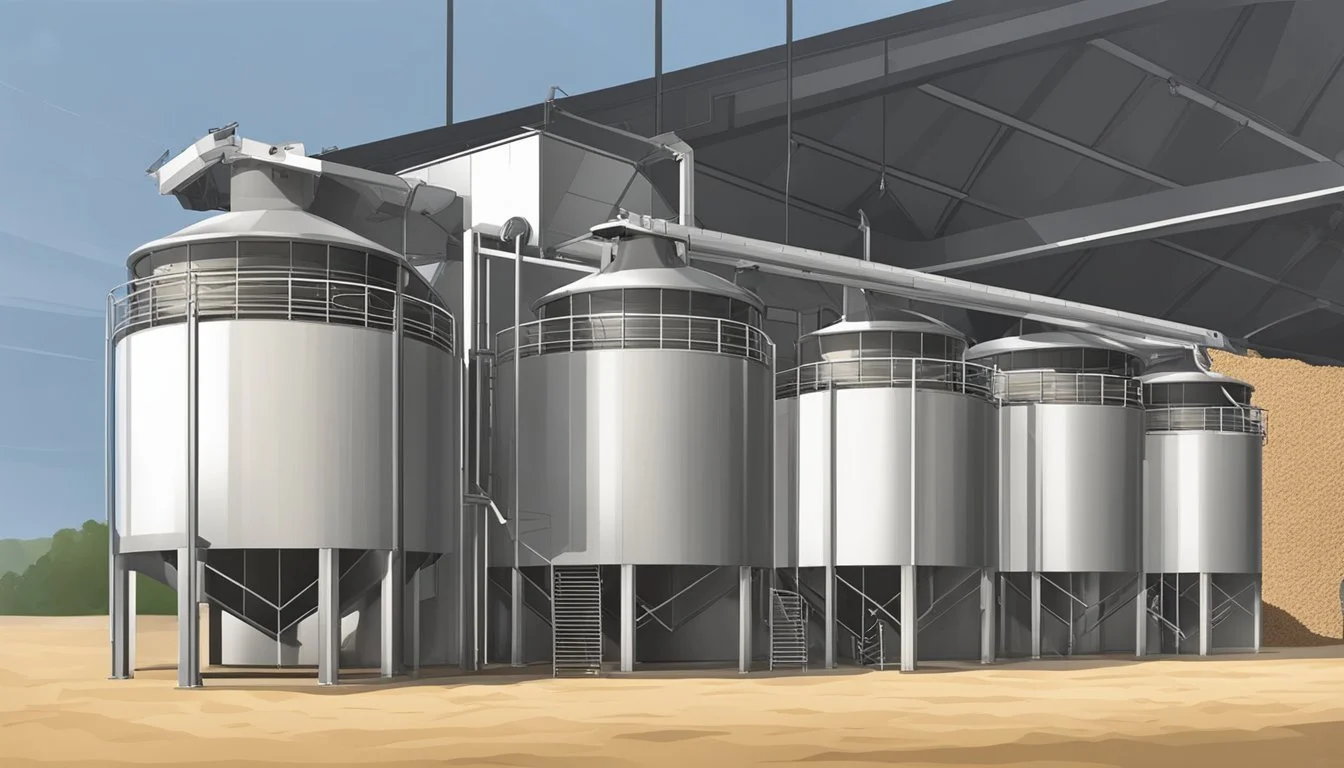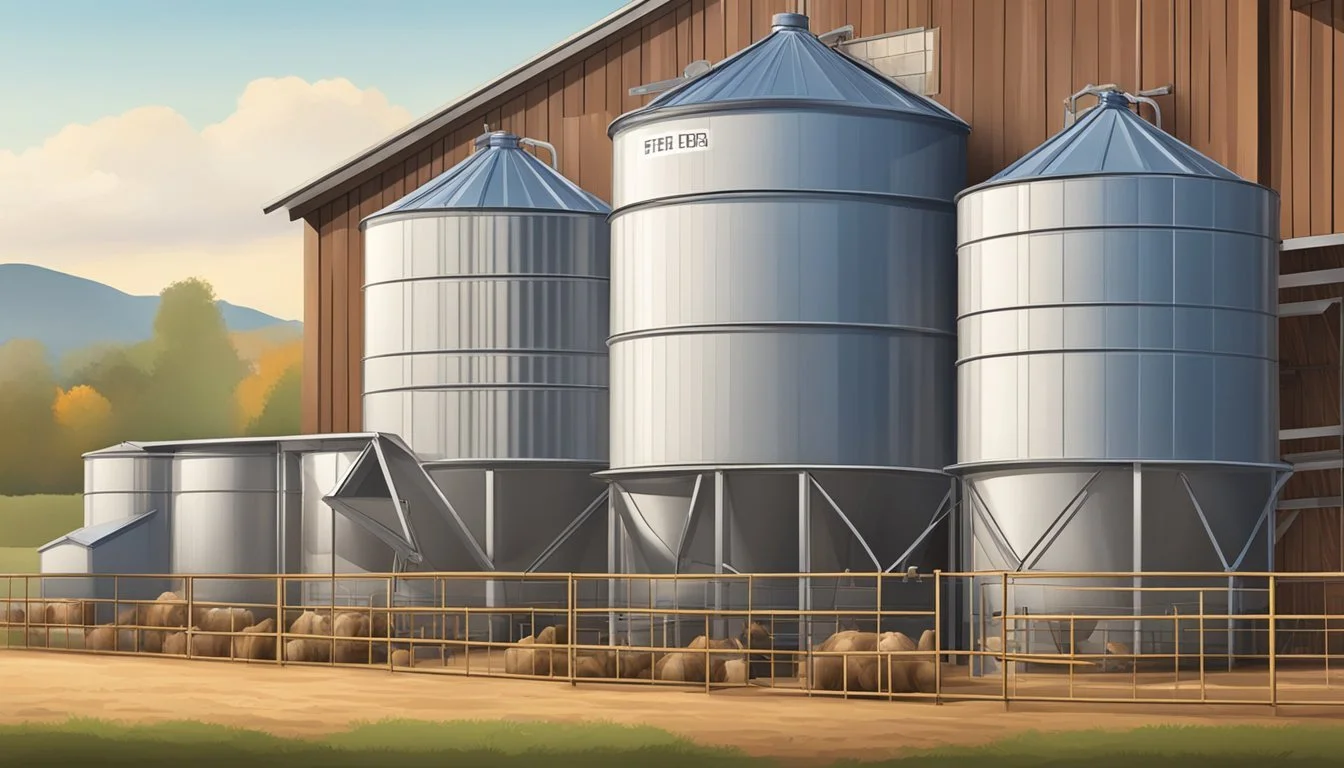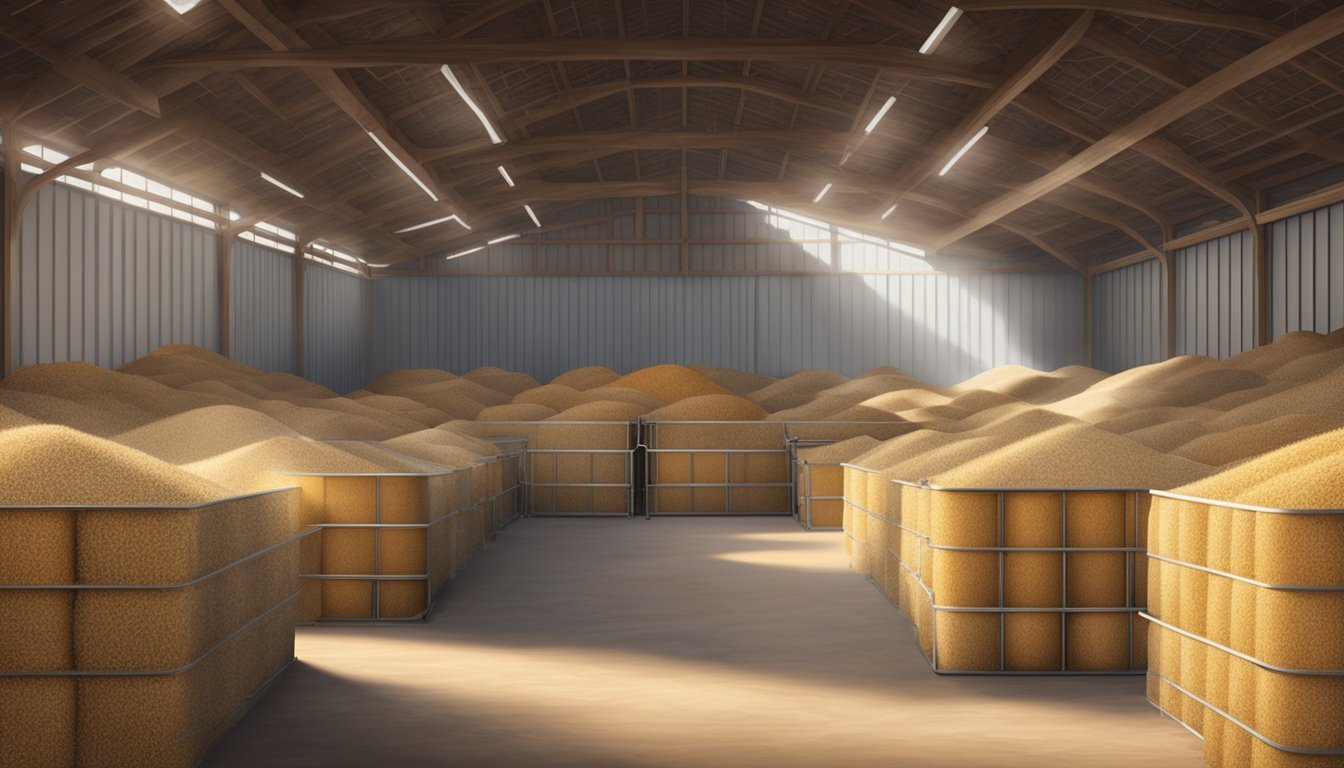What is the Best Way to Store and Handle Cattle Feed
Essential Tips for Optimal Nutrition Preservation
Storing and handling cattle feed effectively is crucial for maintaining feed quality and ensuring the health and productivity of livestock. The primary goal is to preserve the nutritional value of the feed while minimizing losses due to pests, moisture, and spoilage. Livestock producers must consider several key practices to achieve this objective.
Feed storage begins with selecting an appropriate location and container. The best storage practices include keeping the feed in a dry, covered area to protect it from moisture, sunlight, and heat. It is essential to implement pest control measures, such as using insect screens and rodent-proof barriers, to prevent infestations that can compromise the feed's integrity.
Handling the feed also plays a significant role in maintaining its quality. Avoiding contamination and maintaining the feed's physical structure are important to ensure the feed remains palatable and nutritionally sound for cattle consumption. Producers must be diligent in their approach to feed storage and handling, adapting their methods according to the type of feed and the environmental conditions of the storage area.
Understanding Cattle Feed and Nutritional Needs
Cattle feed plays a critical role in the overall productivity and health of livestock. An understanding of the fundamental nutritional components and the necessity of a balanced diet is vital for the welfare of cattle.
Fundamentals of Animal Nutrition
Animal nutrition revolves around the inclusion of essential nutrients in a cattle's diet to ensure proper growth, reproduction, and maintenance of bodily functions. There are six basic classes of nutrients that animals require: water, proteins, fats, carbohydrates, vitamins, and minerals.
Proteins are crucial as they are the building blocks for body tissue, while carbohydrates serve as the primary energy source. Fats provide an energy reserve and carry fat-soluble vitamins. For roughage, fiber is essential in the diet to aid in digestion and maintain gut health. Vitamins and minerals, although required in smaller quantities, play significant roles in various physiological processes.
Importance of Balanced Diet for Livestock
A balanced diet ensures that cattle receive the appropriate amounts of each nutrient. The nutritional requirements of beef cattle can vary based on their age, weight, reproductive status, and health.
It is crucial to provide a range of feeds to cover the complex vitamin and mineral needs of cattle. For instance, micronutrients like selenium and zinc are important for immune function, while calcium and phosphorus are vital for bone development and maintenance. A deficiency or excess of these can lead to health problems, thus a fine balance must be achieved for optimal livestock health and productivity.
Types of Cattle Feed
Choosing the right type of cattle feed is crucial for the health and productivity of the herd. Different feeds fulfill varying nutritional requirements, and understanding each category is key to effective feeding management.
Forage and Roughage
Forage and roughage are the foundation of cattle nutrition, typically consisting of pasture and hay. Pasture is the natural diet for cattle, offering a balance of nutrients in a form they are evolutionarily adapted to graze. Hay, whether grass or legume, serves as a preserved form of pastures, providing essential fiber that aids in cattle digestion. Silage, which is fermented high-moisture fodder, can also be a vital component, particularly when fresh forage is scarce.
Grains and Supplements
Grains, such as corn and oats, are energy-rich feeds often used to supplement a forage-based diet. Proper grain storage is essential to preserve their nutritional value and prevent spoilage. Supplements may include vitamins and minerals to address any deficiencies in the cattle's diet and are vital for growth, reproduction, and overall health. Creep feeding — the practice of offering supplementary feed to nursing calves — often incorporates grains and formulated supplements to promote early growth.
Specialty Feeds
Specialty feeds are formulated to meet specific nutritional needs that cannot be met by forage, roughage, or grains alone. These feeds might include cattle cubes, pelleted feed, or textured cattle feed, designed for specific life stages, productivity levels, or health requirements. They are carefully balanced to provide protein, energy, vitamins, and minerals in precise amounts.
Planning Your Feed Storage
Proper feed storage is critical to ensure the quality feed remains intact throughout its shelf life. This section guides on effectively rotating stock and assessing the necessary quantities of feed.
Feed Rotation and Shelf Life
When storing animal feed, it is essential to adhere to the "first in, first out" principle to maintain feed freshness and nutrient integrity. Feed shelf life varies based on the type of feed; therefore, it's crucial to understand the expiration dates and use older stocks before newer ones. Implementing a structured system such as date labeling can aid in effective rotation.
Calculating Feed Requirements
Calculating the correct amount of feed is foundational for maintaining an efficient feed storage system. Overestimating leads to waste and potential spoilage; underestimating could cause shortages. One should consider the specific dietary needs of the livestock, the number of animals, and the feeding duration to determine precise feed requirements. Inventory checks should be scheduled regularly to adjust the purchasing and storage plans accordingly.
Designing a Storage System
When creating a system to store and handle cattle feed, it is essential to select the appropriate storage containers and design on-farm storage facilities that protect feed from moisture, provide adequate ventilation, and prevent degradation from light.
Types of Storage Containers
The selection of feed storage containers is crucial for maintaining the quality and longevity of livestock feed. Common options include:
Metal Trash Cans: They are airtight and effectively protect feed from rodents and pests. Their portability makes them suitable for smaller operations.
Silos: Ideal for large quantities, silos are designed for bulk storage and are typically equipped with mechanisms for easy unloading. They come in various types, such as tower, bag, and bunker silos, each with specific advantages.
Each storage type must preserve feed quality by minimizing exposure to light, moisture, and extreme temperatures, all of which can significantly impact feed nutrition and safety.
On-Farm Storage Facilities
Designing an on-farm storage facility involves more than selecting containers; it encompasses the entire system's infrastructure:
Ventilation: Adequate airflow is necessary to keep feed dry and cool, reducing the risk of mold growth and spoilage.
Moisture Control: The facility must be waterproof to prevent feed degradation and built in a way that diverts water away from stored feed.
These features ensure that the quality of the livestock feed storage is maintained, thereby supporting farm efficiency and the health of the cattle.
Maintaining Feed Quality
Proper storage and handling of cattle feed are critical for preserving its nutritional value and preventing spoilage. Attention must be given to moisture control, pest management, and regular quality assessments to ensure feed safety and effectiveness.
Preventing Moisture and Mold
To avert the growth of mold and the onset of mildew, it's essential to maintain optimal moisture levels in feed storage areas. They should be clean, dry, and well-ventilated. The use of sturdy, airtight containers can also help keep feed fresh and protect it from the elements. Regular inspections for water leakage or spills are crucial as they can lead to mold contamination and feed spoilage.
Protection Against Pests and Rodents
Feed storage areas must be secure from pests, including rodents such as rats and mice, which can cause contamination and feed loss. Implementing a cleaning schedule is vital to reduce attractiveness to pests. Furthermore, storage practices need to include ensuring that the feed is inaccessible to pests by using rodent-proof containers and maintaining a clutter-free environment to discourage nesting.
Feed Testing and Quality Checks
Conducting regular feed testing is a definitive approach to assess feed quality and detect potential issues. This involves checking for the presence of contaminants and ensuring the feed adheres to nutritional standards. Quality control measures include inspecting for spoilage indicators such as off-odors or discoloration, and testing samples for harmful microorganisms or chemical residues to guarantee the safety and efficacy of the cattle feed.
Feed Handling Best Practices
Proper feed storage and handling are crucial in maintaining the quality of cattle feed while minimizing waste and preventing the growth of bacteria and fungi. Attention to temperature and humidity control, along with the use of correct loading and unloading techniques, can significantly impact the feed's longevity and nutritional value.
Proper Loading and Unloading Techniques
Loading:
Avoid contamination: Before loading, ensure that the transportation and storage units are clean and free from contaminants.
Use proper equipment: Employ the correct machinery for loading to ensure that the feed is not crushed or damaged, maintaining its nutritional integrity.
Unloading:
Minimize exposure: During unloading, reduce the feed’s exposure to the elements, such as rain or excess sunlight, to avoid spoilage.
Controlled environment: Unload directly into a climate-controlled storage unit to maintain consistent feed quality.
Monitoring Feed Condition During Storage
Temperature & Humidity:
Climate control: Maintain the storage area at optimal temperature and humidity levels to prevent the growth of harmful bacteria and fungi.
Regular checks: Regularly monitor the storage environment using thermometers and hygrometers to detect any fluctuations that may affect the feed quality.
Feed Maintenance:
Inspect regularly: Inspect the feed periodically for any signs of spoilage, pest infestation, or moisture accumulation.
Rotate stock: Utilize a "first-in, first-out" system to reduce the chances of feed waste and ensure the oldest stock is used first.
By adhering to these best practices in feed handling, one can extend the usable life of cattle feed, promote efficient feeding practices, and contribute to the overall health of the herd.
Security Measures for Feed Storage
The proper security of feed storage is crucial to maintain feed quality and deter pests. Implementing robust locking mechanisms and strategies to ward off wildlife and domestic animals are foundational to this endeavor.
Locking Mechanisms and Seals
Feed containers equipped with heavy-duty locks provide a reliable barrier against unauthorized access. Utilizing a combination lock or padlock can serve as a powerful deterrent. Moreover, the seals on feed storage units should be checked regularly to ensure they are intact and effective in preventing exposure to moisture and contaminants. Bungee cords, although not as secure as locks, can be employed as a temporary solution or an added layer of security to keep lids in place.
Deterring Wildlife and Domestic Animals
To prevent wildlife such as birds from accessing the feed, storage areas must be sealed to deny entry points. Utilizing bird netting can deter avian pests from contaminating or consuming the feed. Similarly, the feed area should be fortified with fencing to restrain domestic animals from reaching the feed. Consistent cleaning schedules and the elimination of leftover feed around storage containers limit attractants that could draw in animals seeking an easy meal.
Innovative Solutions for Feed Storage
In the world of cattle feed storage, practicality and ingenuity are key. Farmers are turning to customizable DIY solutions and clever repurposing strategies to keep livestock feed fresh, and accessible.
DIY Storage Options
Creating a DIY feed bin stands out as a cost-effective method to safeguard cattle feed. A well-designed bin, crafted from galvanized steel or wood, provides necessary protection against moisture and pests. Farmers should ensure a tight seal and consider a roof or lid that slopes to prevent water accumulation. Additionally, the bin size ought to be tailored to the herd size and the frequency of feed delivery to maintain feed freshness.
Improvised Containers and Repurposing
Resourceful farmers have found success using old refrigerators or freezers as bulk feed storage units. These appliances possess an inherent seal that secures against pests and maintains a dry environment, ideal for grain. Similarly, repurposing an ice maker bin, which is insulated, can serve as an alternative feed container for small-scale operations. With such repurposing, it is crucial to thoroughly clean the interiors to prevent contamination and to ensure they are completely defunct and safe to use.
Feed Storage in Different Climates
Climate, temperature, and humidity have significant impacts on the integrity of cattle feed. It's important to tailor feed storage solutions to local weather conditions to maintain feed quality.
Cold Weather Storage Solutions
In cold climates, the primary concern is preventing feed from becoming damp and subsequently freezing, which can lead to mold development when thawed. Insulation is key—storage containers should be well-insulated to safeguard against temperature fluctuations. It is advisable to keep feed in a dry, covered area, and use sturdy containers that seal tightly to bar moisture ingress. Monitoring temperature within the storage area helps ensure it remains consistent, preventing condensation which could compromise feed quality.
Managing Feed in Hot and Humid Conditions
When storing feed in hot and humid conditions, the focus shifts to preventing spoilage and pest infestation. Feed should be kept in a cool, dry place, away from direct sunlight as heat can accelerate degradation. Utilizing climate-controlled storage solutions or placing feed in areas with good air circulation can mitigate the risks. Additionally, it is crucial to implement a robust system to control humidity levels—consider the use of dehumidifiers or moisture absorbing products. Regularly checking feed for signs of spoilage or infestation will ensure that any issues are dealt with promptly.
Waste Management and Feed Efficiency
Effective waste management and enhancing feed efficiency are critical factors in cattle feeding operations. They are keenly focused on reducing any unnecessary loss and optimizing the nutritional value of feedstuff. Careful storage and handling can lead to a significant reduction in feed spoilage, while a well-planned feeding program can drive down the waste substantially.
Minimizing Feed Spoilage and Loss
Proper storage is the first step to ensuring feed quality and minimizing losses. Feed should be kept in pest-proof feed bins that guard against moisture, rodents, and birds. These bins also help preserve the nutritional content of the feed. For hay storage, particularly with large round bales, choosing a covered environment limits exposure to elements that can degrade the feed. Reducing feed waste starts with understanding how feed deterioration occurs and taking measures to prevent it.
Store large round bales on a well-drained area to prevent moisture accumulation.
Use covered structures or tarps to protect bales from precipitation and sun.
Consider using a bale feeder that can reduce hay waste during feeding.
Optimizing Feeding Programs for Waste Reduction
An efficient feeding program is designed to match the herd's nutrient requirements with the appropriate feed types and amounts, minimizing excess and spoilage. This includes calculating appropriate rations and observing cattle behavior to reduce overfeeding or underfeeding. Using a bale feeder for hay can prevent trampling and fouling, which are major contributors to feed waste.
Adjust feeding rations based on cattle weight, condition, and production stage.
Implement regular feedbunk management to monitor and adjust feed amounts.
Utilize feed equipment, such as a bale feeder, to minimize hay contact with the ground, reducing spoilage.
Through these targeted strategies, cattle producers can attain a high degree of waste management and feed efficiency, ensuring the sustainability and profitability of their operations.
Specific Feeding and Storage Needs for Various Livestock
The optimal storage and handling of feeds differ among various types of livestock, with factors like growth stage and feed type playing critical roles.
Cattle
For cattle, especially calves, it is crucial to store feed in a manner that preserves its nutritional value and prevents contamination. Calves require high-quality feed to ensure proper development. It is advisable to store cattle feed in livestock feed storage containers that are waterproof and placed off the ground to prevent moisture seepage and pest infestation.
Being ruminants, cattle benefit from forages that are stored in a way that prevents mold and spoilage. For example, hay should be kept in a dry environment with good air circulation.
Sheep
Sheep feed storage requires measures to protect against the dampness that can lead to the growth of harmful organisms. Proper feed handling for sheep includes:
Keeping feed dry and well-ventilated to maintain nutritional quality and prevent respiratory issues from poor-quality feed.
Storing feed in rodent-proof containers, as even a small amount of contamination can lead to diseases within a flock.
Pigs
Pig feed needs to be stored in a way that maintains the integrity of its nutrients. Pigs, unlike ruminants, consume more grain-based feed, which can be susceptible to spoilage:
Ensure that pig feed is kept in cool, dry locations to prevent the growth of mold and spoilage.
Utilize sturdy containers that seal well to keep out pests and maintain the quality of the pig feed over time.
For all livestock, it's essential to regularly check storage facilities for signs of damage, moisture, and pest activity to ensure feed remains safe and nutritious for animal consumption.
Concluding Remarks
Proper storage and handling of cattle feed are crucial for maintaining the health and productivity of livestock. They should follow certain best practices to ensure feed quality and safety.
Storage:
Store in a cool, dry place to prevent mold and spoilage.
Use pest-proof facilities and maintain cleanliness to deter birds and rodents.
Keep feed covered to protect it from the elements.
Handling:
Implement a feeding protocol that includes a 21- to 28-day transition period for newly received calves.
Use feed types like cattle cubes and pelleted feed to efficiently supplement forage diets.
Health and Safety:
Ensure that feeding practices promote rumen health and do not stress the livestock, benefiting weight gain and reducing disease.
By adhering to these guidelines, feed storage and handling can be optimized to support cattle welfare and operational efficiency. It's not only ethical but pragmatic, leading to better feed conversion and overall herd health.








